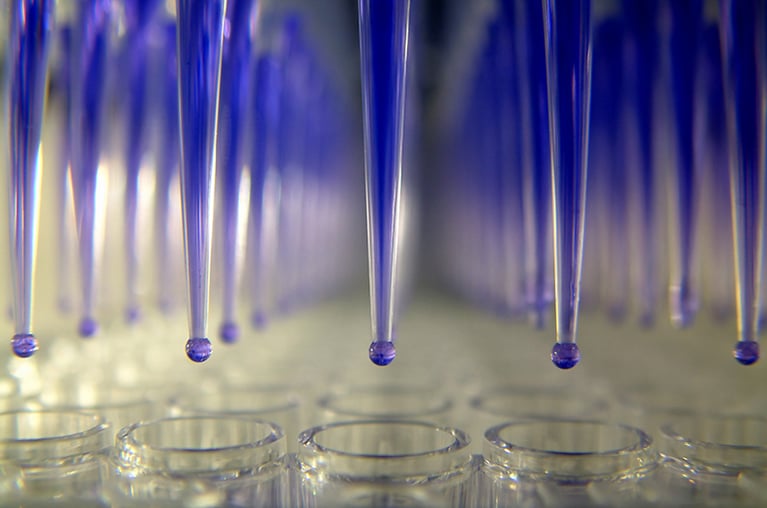By Dr Beatrice Marg-Haufe
The COVID-19 pandemic has forced everyone to look at laboratory routines to see if they are really pandemic proof. For example, the explosive demand for high throughput genomic analysis often creates pressures upstream to process many more samples and prepare high quality DNA. The rapid shut down of non-essential workplaces and services coupled with the surge in demand for laboratory testing put immense strain on multiple aspects of normal laboratory operations such as strict rules on the need for personal protective equipment which was in limited supply and required physical distancing. Consumable stocks and reagents also dwindled as they were being used at a much faster rate and the supply chains were affected by global demand. Now that limitations of current laboratory routines have been highlighted, it’s time to consider how to make laboratories pandemic proof.

Identifying weak links in laboratory workflows
The COVID-19 pandemic has highlighted three main weaknesses that could prevent laboratories from being fully operational during a pandemic. The first is the ability of labs to carry out routines while physical distancing rules are enforced. In order for labs to function, every part of the laboratory routine has to be optimized to reduce the contact between workers in the lab. If laboratories are full of equipment, there is less room for people to move and keep a safe distance. However, having a lot of empty floor space is expensive to maintain and doesn’t contribute to lab productivity. The tradeoff often leads to workflow compromises that can significantly decrease throughput of sample preparation and processing.
The second weakness is that laboratories often have to quickly adapt procedures and workflows to accommodate new methods and testing kits that are required as a result of a pandemic. Implementing new methods will almost inevitably require development, optimization and validation in the lab, which will delay the start up and reduce the overall capacity of the lab.
The third weakness of typical laboratories is the ability to scale up rapidly during a pandemic. The problem of scale-up is often compounded by the inability of lab personnel to work effectively under physical distancing, but that is by no means the only contributing factor. Limitations in the capacity of lab equipment and the lack of access to necessary reagent kits during supply chain disruption can cause labs to shut at the very time when they should be rapidly scaling up to meet rising demand. However, there are many examples of how labs have overcome these limitations such as at the PTP Science park in Northern Italy who were able to scale up their COVID-19 testing capacity at the height of the pandemic.
Workflow Optimization
To be able to remain operational as well as able to adapt and scale up during a pandemic, all laboratory workflows have to be audited and potentially optimized. Labs will also have to consider how they plan to ensure any new kits and methods are incorporated into the workflow to avoid downtime or a loss of flexibility.
First of all, it is important to consider how people and samples will move throughout the laboratory. During a pandemic, if physical distancing is required, it is important that the paths people need to take while carrying out laboratory routines are simple, easy to follow, and don’t cause bottlenecks. This is exactly the same for sample preparation. Having a simple series of sequential workflow steps that are easy to follow will make the laboratory safer and more able to accommodate scale-up. When considering sample preparation, it is important to separate the areas where clinical samples are handled and inactivate any infectious material as quickly as possible. The floor plan of the COVID-19 testing facility at the PTP Science park is a good example of how to accommodate different sample preparation areas.
A good way of optimizing workflows so that they can continue to run during a pandemic is to consider lab automation. This allows you to reduce the risk for laboratory staff. If done in a smart way, it will also smooth scale-up whenever it is needed. A key feature of lab automation solutions is the “walk away time” which is the amount of time the equipment can be left alone without the need for human intervention. Manufacturers of lab automation are constantly striving to improve this feature, which is why many automated systems strive to cover extended parts of the workflow to minimize the personal interaction required during each workflow step and in addition allow for remote monitoring of single or multiple instruments, e.g. using Tecan’s Connect™ app.
The value of open, modular solutions
There are many excellent off-the-shelf solutions when it comes to lab automation. These can come in either open or closed configurations. Closed solutions are designed to do one specific task, are less flexible, and are often limited in throughput. Open solutions are modular and can be freely adapted depending on the task. For example the Freedom EVO™ and Fluent® automation workstations have a configurable layout so that they are flexible enough to fulfill a number of uses in the same lab. One of the biggest benefits of off-the-shelf solutions is that they are much faster to install and bring online than bespoke solutions. In the case of the PTP science park, they installed liquid handlers and several modular automation systems including nucleic acid extraction with DreamPrep NAP and a Freedom EVO workstation. This huge upgrade could have caused significant disruption to the lab, but through the use of the off-the-shelf components and pre-developed protocols, everything was installed and online in less than a week.
Modular components and systems often work extremely well with standard protocols and outputs. For example, commercially available kits will often fit perfectly into the workflow of lab automation solutions. By the same token, the outputs from these systems are extremely robust and easily standardized. This is important in cases like COVID-19 testing when large amounts of data have to be processed in a standardized way and submitted to national and international databases.
A modular approach allows for lots of different configurations to accommodate many different applications, kits and protocols. For example, automation workhorses like the Freedom EVO or the Fluent® automation workstations can be easily configured for a wide range of potential applications—from sample preparation and assay set-up to ELISAs. In the best cases, a modular approach enables automation solutions to be more flexible, meaning that labs are not tied to one particular method or reagent kit. Modularity is an important consideration not only for the hardware but also when it comes to the software controlling your lab automation. When software is modular and accessible to be programmed by end-users it enables developers to quickly adapt and design what’s needed for the problem at hand—whether it be changing which particular kits to run or how the results are reported, or anything in between. An example is the Tecan Connect™ app, which alerts users of the instruments status but also integrates with the customization service IFTTT, allowing users to provide unique and automated responses to different instrument conditions. It is also possible to use the Tecan Introspect™ software to monitor instrument and consumable usage over time, which helps keep track of inventory as well as justify capital investment for instruments.
The benefits of being well prepared
Being prepared for a pandemic is an exercise in mitigating risk, which is an essential part of running a lab. However, there are also many benefits to the routine business of a laboratory by making it pandemic ready. The improved efficiency and employee safety will improve the results and the working environment, while the adoption of more flexible automation workflows will mean that scaling up and down to meet demand can be done simply. The PTP science park in Northern Italy recently upgraded their laboratory to handle 800 COVID-19 samples per day, running 16 hours per day and 7 days per week. CEO, Andrea Di Lemma and Laboratory Coordinator Francesca Visentini recently explained how this was possible in a webinar presenting details on the equipment and organization that was needed for such a significant upgrade.
About the author

Dr Beatrice Marg-Haufe
Dr. Beatrice Marg-Haufe is a product manager at Tecan Switzerland with over 10 years of experience in assay development and product management. She studied biochemistry at the University of Bielefeld, Germany, and at Harvard Medical School, USA. She focused on cancer research during her PhD in Biochemistry at the MPI, Munich, Germany. She joined Tecan in 2009 focusing on applications for the agriculture and genomics market.











